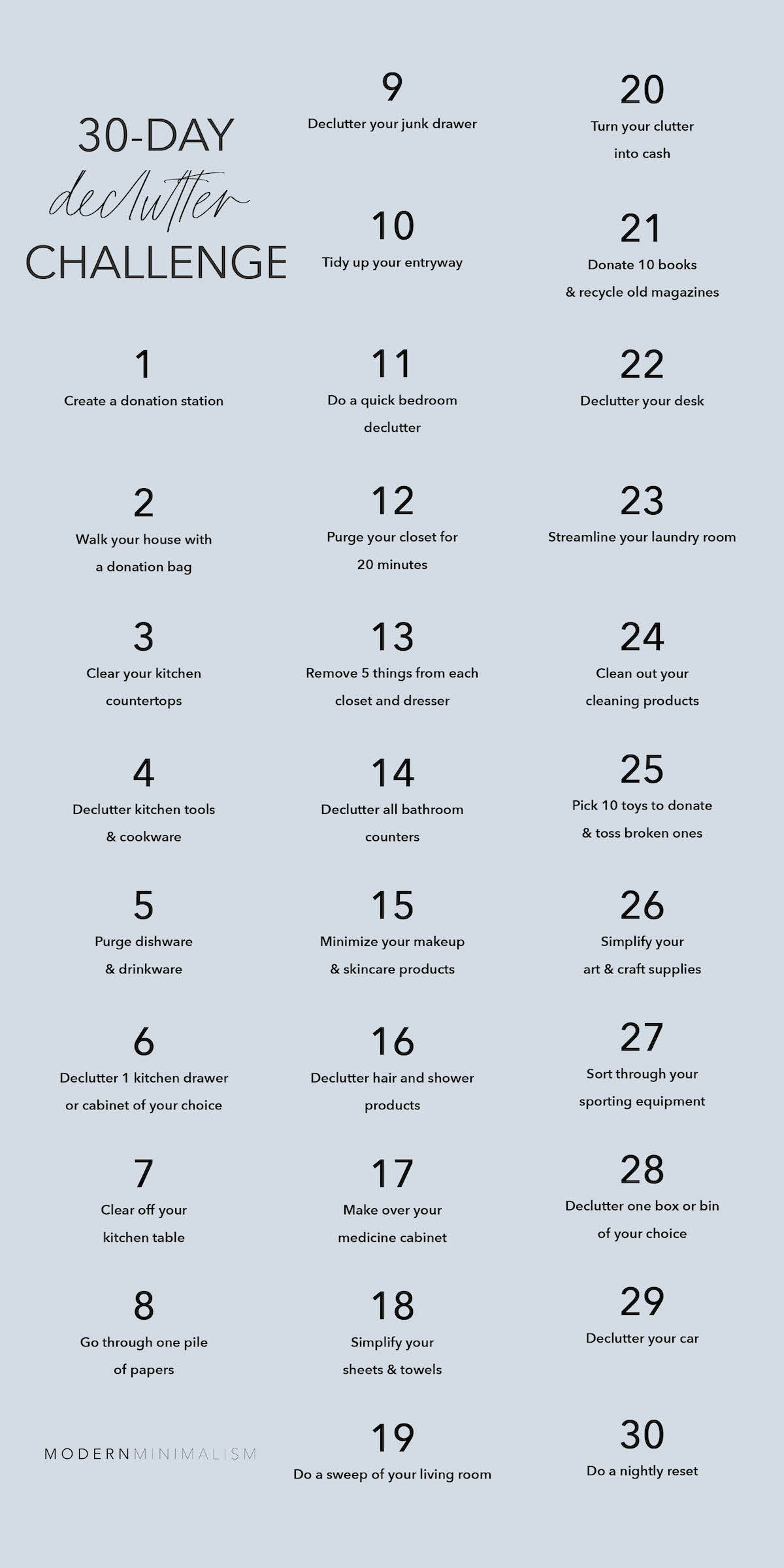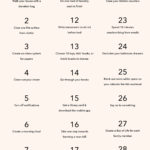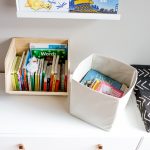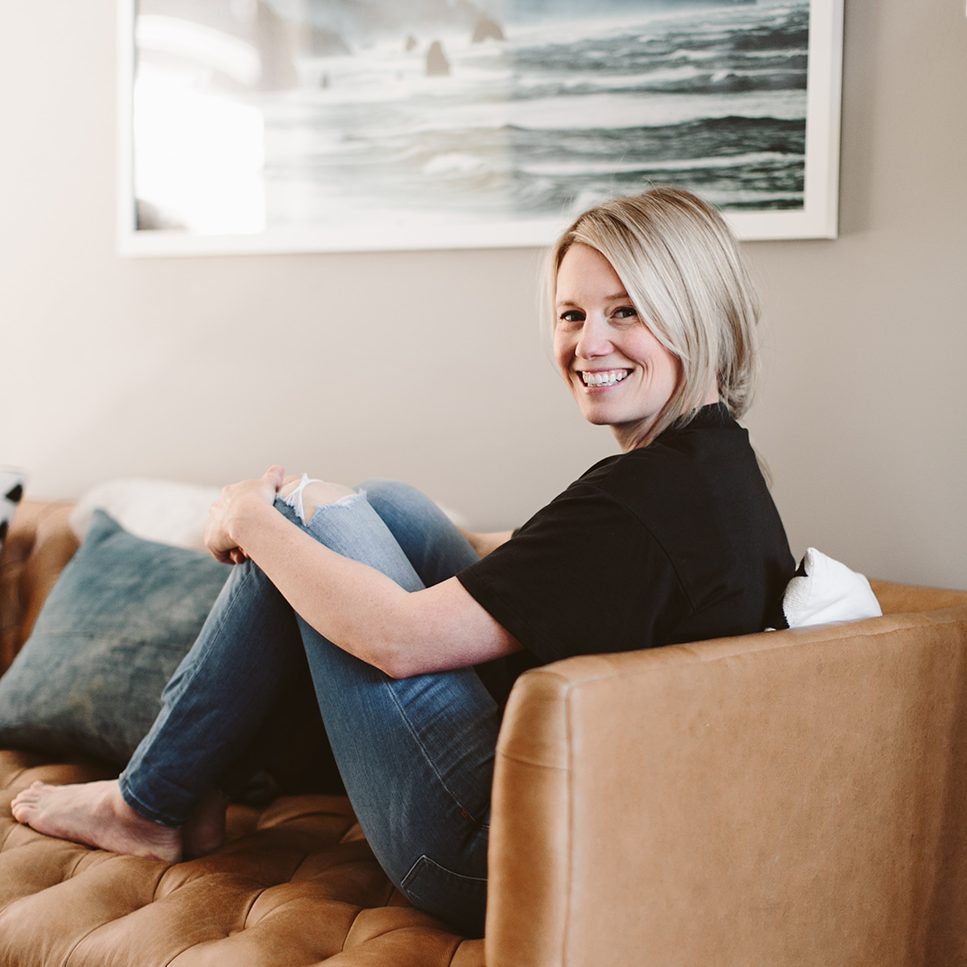Want to declutter but don’t know where to begin? Start with this easy 30-Day Declutter Challenge —30 simple decluttering assignments you can do in 20 minutes or less.
Over the next month, this challenge will help you reduce the clutter in your home and add more space and ease to your everyday. In the end, you’ll be more aware of what adds value to your life and more comfortable letting go of what doesn’t.
If you’d like to keep track of your assignments and progress, fill out the form below to get your own printable 30-Day Declutter Challenge calendar.
How this declutter challenge works
The challenge is simple. Just choose one task to do each day for the next 30 days. I recommend going in order if you are able; however, if this doesn’t work for you, you can jump around after the first assignment. Assignment #1 takes just a few minutes but is one of the most important, so be sure to do that first.
I also suggest giving yourself a 20-minute time limit on each assignment. Why? Because I know decluttering sessions can easily spiral into a half-day affair, leaving you feeling overwhelmed and overworked. These assignments are meant to be quick, easy, and build momentum. Setting a timer will also help you stay focused on the task at hand and push you to make decisions more quickly.
Now let’s go over a few key things, including:
- Why decluttering is important
- How often you should declutter
- Questions to ask yourself when you’re decluttering
Why decluttering is important
There are many benefits to decluttering your home. Here are just a few:
- Decluttering can lower stress levels. For most people, cluttered surroundings increase stress levels. In one study, women who described their homes as cluttered or unfinished had higher cortisol levels than women who described their homes in a positive way. Reducing clutter can be incredibly helpful for lowering the amount of stress you feel both inside and outside your home.
- You’ll spend less time looking for stuff. Clutter makes it challenging to find what you need, which leads to wasted time and money spent rebuying items you can’t locate. Getting rid of household clutter makes it easier to find what you need when you need it.
- You’ll feel more in control and have better focus. You’re more likely to feel scatterbrained and distracted in a cluttered space. Simplifying your surroundings and limiting visual clutter will help you feel calmer and stay focused on what you need to do.
- Decluttering can improve your relationships. Clutter can bring about conflict with family or roommates and make you feel embarrassed about your home. Decluttering can alleviate clutter-related conflicts with those you live with and help you feel more comfortable inviting others into your home.
- Decluttering will make your home more functional and easier to maintain. You’ll find it easier to prepare meals in an uncluttered kitchen and your home easier to clean when you don’t have to work around piles of personal belongings.
How often should you declutter?
You should declutter your house at least once every few months, if not on a daily or weekly basis. If you have a cluttered home, decluttering can feel overwhelming because you don’t know where or how to start. It’s better to do a little each week than to let things pile up for long periods. The more often you do it, the easier and less daunting it will be.
Questions to ask yourself when decluttering
At some point during your decluttering journey, you’ll come across something you won’t know whether to keep or get rid of. Here are some decluttering questions that will help you make the right decision, quickly.
- Do I love it?
- Do I use it? If so, when did I use it last?
- Do I need this item?
- Do I own a duplicate or something very similar to this?
- Do I want this item in my life in the future?
- Do I have something else that serves the same purpose?
- Does this item work? If not, will I realistically repair this, or can it be recycled or donated for parts?
- Would I buy this item again?
- Are you only keeping this item out of guilt?
- Is this something I could easily borrow in the future?
- Did I remember I even had this?
- Would I miss it if it were gone?
- Is this item worth the time, space, money, and energy it’s costing me to keep it?
- Does this item suit my current lifestyle?
- In what situation would I want or need this?
- Is this something I will repair in the next week, or can I donate it to someone who will?
30-Day Declutter Challenge Assignments
Below are details on all 30 challenge assignments. Let’s go!
1. Create a donation station.
Decluttering becomes easier when you have a place to stash the things you don’t want (including items you want to sell, consign, or recycle) until you can permanently remove them. Find a large cardboard box or basket and choose a place to put it — somewhere out of the way but that’s easy to access, like a garage, basement, or closet. When the box gets full, donate the contents and return it to its designated place to fill it again. This donation station will be a permanent addition to your home. Encourage family members to regularly contribute stuff they no longer want or need during and after the challenge.
2. Walk your house with a donation bag.
Grab a trash bag and see if you can fill it with things you don’t need, use, or love around the house. Place the bag next to your donation station, which you’ll fill up in the coming days.
3. Clear your kitchen countertops.
Relocate or donate decorative items from your kitchen counters, like candles, knick-knacks, and vases. Put dry dishes away and replace your dish rack with a large, clean dish towel. (It will look less cluttered and prevents drying dishes from piling up quite as much.) Put away small appliances you don’t use daily. Find a home for anything else that doesn’t belong on your counters, and wipe them down with a clean, damp cloth.
4. Declutter your kitchen tools and cookware.
Donate duplicate kitchen tools, things you rarely use, and single-use kitchen gadgets that you can use something else to do. Toss anything that’s broken or rusted, and appliance manuals and accessories you haven’t used. Wipe down your drawers and utensil holders before putting items back, placing your frequently used items where you use them most.
5. Purge your dishware and drinkware.
Declutter any dishware you don’t need, love, or regularly use. Keep only enough plates, bowls, glasses, mugs, and water bottles for the number of family members you regularly serve. If you need additional dishware for larger gatherings, keep a few extras out of the way of the things you use every day.
6. Declutter 1 kitchen drawer or cabinet of your choice.
Pull everything out. Wipe it down, and put back only what belongs there, and that you need and use regularly. If your kitchen needs a full declutter, go ahead and pin this post on how to declutter your kitchen for later!
7. Clear off your kitchen table.
Take everything off of your table and give it a good wipe-down. Only put back the things that you’d use while eating, like the salt and pepper shaker, a napkin holder, and some coasters. Find a permanent home for anything else that doesn’t belong.
8. Go through one pile of papers.
Open all unopened mail. Place papers you need to take action on in a neat pile on your desk and choose a specific time this week to deal with them. File or scan important documents you need to hold on to. Recycle junk mail, old receipts, and any other unnecessary papers. If you’ve got a few extra minutes, unsubscribe from unwanted catalogs and mailing lists to drastically reduce the amount of paper clutter coming into your house.
9. Declutter your junk drawer.
Before you touch a thing, decide what your junk drawer will hold. In mine, I keep a few pens, pencils, Sharpies, Post-Its, some rubber bands, paper clips, hair ties, a small hairbrush, and a mini flashlight. Toss anything you don’t need and find a new home for whatever doesn’t fit or belong.
10. Tidy up your entryway.
Choose 1-2 coats and 1-2 pairs of shoes to keep in the entryway for each family member. Return everything else to bedroom closets and find a home for anything that doesn’t belong. Hang up jackets, backpacks, and purses and put frequently used accessories in baskets.
11. Do a quick bedroom declutter.
Hang clothes in the closet that are strewn on the bed, chair, or floor. Find homes for things that don’t belong in the bedroom. Donate decor you don’t truly love. Hang pictures currently sitting on your dresser or bedside table. Find a new home for anything on (or in) your bedside table you don’t need or use while in bed.
12. Purge your closet for 20 minutes.
Set a timer and work as quickly as you can to remove the following: stained or damaged clothes, clothes that don’t fit, you don’t love, haven’t worn in a while, or don’t suit your current lifestyle.
13. Remove 5 things from each closet and dresser.
Visit every bedroom in the house and choose at least 5 things to get rid of from each, like unmatched socks, stained or damaged clothing, clothing, or shoes that have been outgrown. Donate items in good condition to a local charity or shelter.
14. Declutter the bathroom counters.
Uncluttered bathroom countertops are the easiest to clean. Pop into each bathroom in your home and remove non-essential items like candles and decor. It’s ok to keep a few things you use daily on the countertop (like hand soap and a toothbrush cup) but try to contain these in a small tray and keep as many items as possible in cabinets and drawers.
15. Minimize your makeup and skincare products.
Get rid of old or rarely used makeup and skincare products, used makeup applicators, extra brushes, and old product samples. Wash your makeup brushes with gentle hand soap and warm water. Wipe down bathroom drawers and makeup bags before putting products back. Keep only the products you use, and use what you have before replacing or purchasing a new product.
16. Declutter hair and shower products.
Toss broken or unwanted hair tools, accessories, and old hair products. Remove duplicate or like products from your bath or shower, including body wash, shampoo, conditioner, shaving cream, face wash, etc. Move these extra products to a cabinet and use those up when you’ve finished what’s in your shower.
17. Makeover your medicine cabinet.
Take everything out and wipe down the shelves. Throw away expired products, medicines, and anything you don’t use. Combine duplicate items and consolidate like items (like first aid supplies) into a single storage bag or container. Combine all backup products into one basket so you know exactly what you have and when you need to buy more.
18. Simplify your sheets & towels.
Choose 2 sheet sets for each bed and donate, recycle, or repurpose the rest. Bundle sheet sets together by placing all matching sheets from a set into one of the pillowcases. For the bath towels, keep 2 per person in your household, and donate or use the rest for cleaning rags.
19. Do a sweep of your living room.
Grab an empty box or trash bag and declutter non-sentimental decor items, including knick-knacks, extra candles (you only need 1-2 out at a time), reed diffusers, throw blankets, and pillows. Toss potted plants you don’t love or that aren’t in good health. Recycle newspapers and magazines you’ve already read.
20. Turn your clutter into cash.
Walk your house and look for something you’re willing to part with for a price. Unused furniture, small kitchen appliances, or larger decor items like lamps, rugs, mirrors, and planters often sell quickly. Dust it off, snap some photos, and write up a quick description that includes the condition, suggested uses, and the value/original purchase price. Post your item on a community forum like Facebook Marketplace, Nextdoor, or Craigslist, and wait for the offers to come in.
21. Declutter your books and magazines.
Donate at least 10 books you’ve already read, never finished, or probably won’t read. Recycle old magazines you’ve saved. If there’s a specific article, recipe, or decor idea you want to reference again in the future, tear out those pages and file them in a binder rather than keeping the whole magazine.
22. Declutter your desk.
Clear off the top of your desk, wipe it down, and put back only the items you need while working. For example, a small lamp, phone and computer charger, a coaster, and a small cup for a few pens, pencils, a pair of scissors, and paperclips. Toss or donate any duplicate office supplies (staplers, tape dispensers, boxes of printer paper or files, etc.), keeping only what you think you’ll use in the next year. Store backup supplies in a desk drawer or on a closet shelf. Recycle or shred old papers. If your desk supplies aren’t organized, look for small containers you already have around the house to group like items together in desk drawers.
23. Streamline your laundry room.
Start a load of laundry, then clear off all flat surfaces in your laundry area, including the top of the washer & dryer. Put non-laundry items back where they belong and donate items you don’t need or want. Streamline laundry products by tossing ones you don’t use and consolidating similar products. Toss socks without a mate, extra clothes hangers, and any other junk that’s collected in this space.
24. Clean up your cleaning products.
Gather all of your cleaning supplies in one place. Consolidate duplicates and toss any you don’t use or that have degraded over time. Throw away old cleaning rags, sponges, and brushes. Plastic dish tubs are great for storing cleaning products and supplies because they keep things organized, can be used when cleaning, and protect cabinets from leaky bottles. If you keep cleaning products throughout the house, only put back the ones you use in those areas.
25. Pick 10 toys to donate & toss the broken ones.
Look for low-hanging fruit like duplicates and toys that have been outgrown or rarely played with. Toss any toys you come across that are broken or missing pieces. If you don’t have toys in your home, choose one drawer or cabinet to declutter instead!
26. Simplify your art and craft supplies.
Go through your art and craft supplies (or one category if you have lots), keeping only the supplies for the things you currently do. Toss items that are nearly gone, old, dried up, or in bad condition. Recycle small scraps of fabric, and donate larger pieces you likely won’t use. Separate and categorize smaller supplies using food storage bags or small containers that you already own.
27. Sort through your sporting equipment. Walk through your garage or basement and declutter sporting equipment that’s been outgrown, that you no longer use, or that’s broken or in an unsafe condition. Donate or sell what you can — keep in mind that broken or old sporting equipment can often be recycled or sold for parts.
28. Declutter one box or bin of your choice.
It doesn’t matter if it’s holiday decor, childhood memorabilia, hand-me-downs, or books you forgot to unpack. Grab a box from the basement, attic, closet, or under the bed, and declutter as much as you can in 20 minutes or less.
29. Declutter your car.
Remove trash and anything that does not belong in your car like clothing, food, purses, backpacks, and shoes. Get everyone on board with taking their belongings into the house when they get out, so clutter doesn’t accumulate in the future. If you have time, give the interior a quick wipe down and a spritz of essential oil air freshener.
30. Do a nightly reset.
Set your mornings up for success by resetting your home before bed. Clear off and wipe down the kitchen counters. Put all dishes in the dishwasher and run it if it’s full. Vacuum the kitchen floor and get the coffee ready to brew in the morning. Pack backpacks and set out clothes, shoes, and coats for the next day. Put dirty clothes in the laundry basket and quickly pick up toys and books. You’ll be amazed at the difference 20 minutes of tidying before bed will make in the morning.
Other decluttering articles you might like
- My 30-Day Minimalism Challenge will help you simplify your home, schedule, and mental load.
- Stressed out by all the toys? Take my 5-Day Toy Declutter Challenge.
- Learn how to declutter your kitchen with my simple, 5-step plan.
- You can also check out my process for decluttering toys and learn what to do with kids books.






Looking forward to the printed copy that I can check any time…..
Thanks!
You go, Elaine!
I can’t wait to declutter my life!
Yasss! So excited for you and happy you’re here. Make sure you join the email list for quick tips and inspiration. 🤍